Calcbench has been paying extra attention lately to supply chain disruptions among large corporate filers, and perhaps there is no better example of the challenge these days than what Apple ($AAPL) had to say about supply chain risks in its annual report from last week.
You might have seen news that on its earnings call, Apple executives admitted that “supply chain constraints” cost the company about $6 billion in revenue for its Q4 2021. Those constraints included microchip shortages plaguing, well, everyone; and operational disruptions at manufacturing facilities in Southeast Asia, where countries have been battling the Delta variant.
Perhaps even more alarming: CFO Luca Maestri said he expects supply chain constraints to be even larger in this quarter, even as revenue continues to hit all-time highs. (Revenue in the September quarter was $83.4 billion, up 29 percent year over year.)
So where would an analyst start with Calcbench to sift through Apple’s disclosures?
We began by cracking open our Interactive Disclosure viewer to see what Apple had to say about supply chain issues. The company said a lot. Take this example from the Risk Factors disclosure:
During the course of the pandemic, certain of the company’s component suppliers and manufacturing and logistical service providers have experienced disruptions, resulting in supply shortages that affected sales worldwide, and similar disruptions could occur in the future … The company’s global supply chain is large and complex and a majority of the company’s supplier facilities, including manufacturing and assembly sites, are located outside the U.S. As a result, the company’s operations and performance depend significantly on global and regional economic conditions.
You can use our “Compare Text” feature to see what new narrative disclosures have been added compared to the previous period’s disclosures. We did that, and found a lot of green text — meaning, new material that Apple had added since the 2020 annual report. See Figure 1, below.

All the green copy in the center column is new material, and it all addresses supply chain risks.
Before we get carried away, however: if one scrolls further down that center column, you’d also find plenty of red text, which indicates material removed from the prior period’s report. In reality, Apple simply reorganized most of its supply chain disclosures to give risks related to Covid-19 and to macro-economic trends more prominence.
Looking at Q4 Numbers
We also examined Apple’s Q4 numbers, which Calcbench automatically calculates in our Company-in-Detail page. Revenue rose from $64.7 billion in the year-ago period to $83.4 billion this year, an increase of 29 percent. Cost of revenue, meanwhile, only rose 20.4 percent: from $40 billion one year ago, to $48.2 billion now. Figure 2, below, shows the comparison for the whole income statement.

Overall those line items look decent, although we’re comparing Q4 2021 figures to the pandemic-battered year of 2020. Perhaps the question for analysts is more about the even better numbers Apple might have achieved, absent supply chain disruptions.
One might also conduct further research to understand are these supply chain constraints more about raw materials and components that Apple doesn’t have; or workforce disruptions due to delta variant outbreaks keeping facilities closed? Calcbench can’t answer those questions for you, but we do have the data to help you understand which questions are the most useful to ask, and get answered.